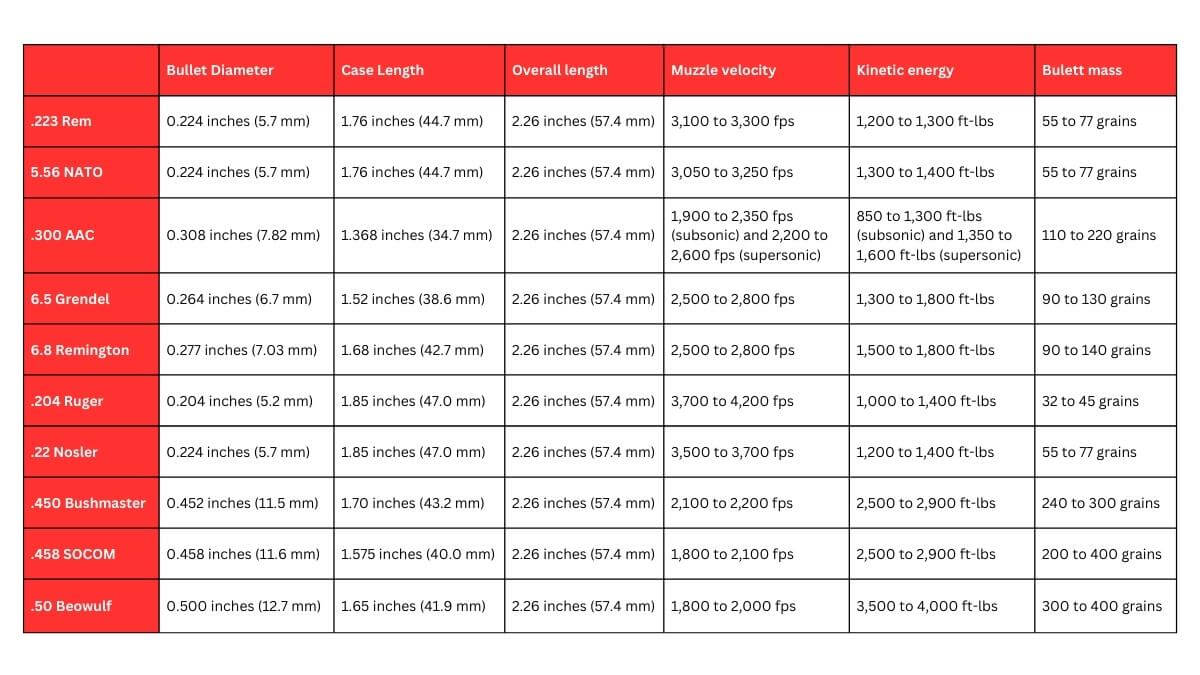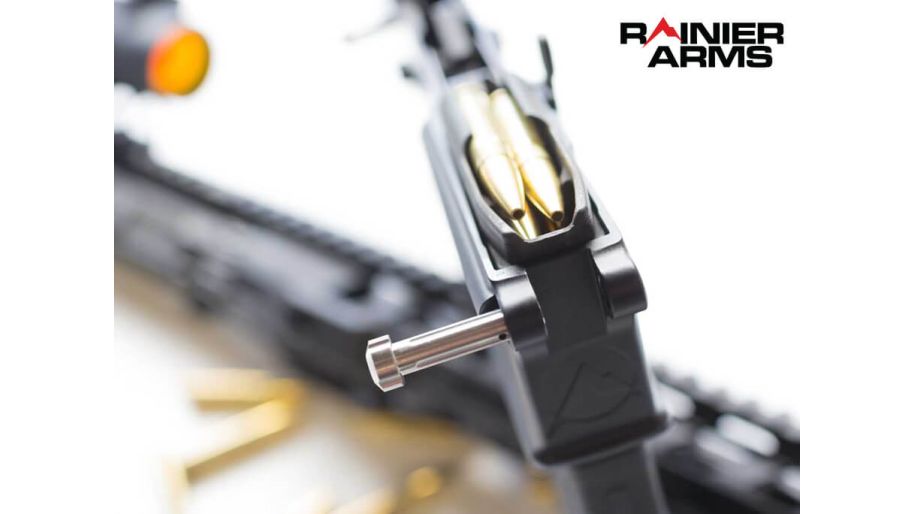AR15 Ammo Comparison - Complete Guide
Most of the AR15 rifles on the market come chambered in 5.56 NATO caliber, also used by the military and police.
However, despite all those facts, people are still looking for something different out there, which is why you can use so many calibers on your AR15 rifle (if you have a proper barrel, of course).
So depending on your needs, sometimes you may need a different caliber for your rifle and because of this, we will review all calibers on the market that can be used in AR15 rifles.
Understanding Caliber and Cartridge Designations
Caliber refers to the internal diameters of a firearm’s barrel and is usually expressed in inches or millimeters. For example, the standard AR15 caliber is .223 Remington or 5.56x45mm NATO. The cartridge designation consists of the caliber followed by the specific load data, such as case length, bullet type, and powder charge.
Different Types of AR15 Rifle Ammunition
Full Metal Jacket (FMJ) Ammo
FMJ ammo is the most common type of AR15 ammo. It features a lead core enclosed in a copper or steel jacket. The jacket not only aids in feeding and extraction but also reduces fouling in the barrel. FMJ ammo is typically used for target shooting, training, and plinking due to its affordable price and reliable performance.
Hollow Point (HP) Ammo
Hollow point ammo is designed with a cavity at the tip of the bullet. Upon impact, the cavity causes the bullet to expand, creating a larger wound channel. This expansion results in greater stopping power and reduced risk of over-penetration, making HP ammo suitable for self-defense purposes.
Soft Point (SP) Ammo
Soft point ammo has a lead-tipped bullet with an exposed lead core. This allows the bullet to expand upon impact but this expansion is lesser than hollow point ammo. SP ammo strikes a balance between FMJ and HP rounds as it has improved terminal performance without affecting too much penetration. This ammo is favorite among hunters.
Match Grade Ammo
Match-grade ammo is made to strict tolerances, making sure it has consistent performance and accuracy. These rounds are commonly used in precision shooting competitions and long-range shooting scenarios, where hitting targets with utmost precision is critical.
Armor-Piercing (AP) Ammo
AP ammo is made to penetrate hard targets like body armor, steel plates, or concrete barriers. These rounds typically feature a hardened steel or tungsten core, capable of piercing through obstacles that standard ammo can’t. However, civilian ownership and use of AP ammo may be heavily regulated in some regions due to safety concerns.
How Bullet Weight Affects Performance
Bullet weight plays a vital role in the performance of AR15 ammo. Generally measured in grains, heavy bullets tend to deliver more energy and penetration making them a great choice for long-range shooting.
On the other hand, lighter bullets have higher velocities and flatter trajectories, making them ideal for target shooting and rapid follow-up shots.
Understanding Terminology
Ballistics and Trajectory
To understand ballistics, we will break it down as simple as possible. It’s a science that studies the motion of the projectiles. And bullets are included there too.
Why understanding ballistics is important for you? Well, knowing how your bullet behaves will help you achieve better accuracy and shoot targets with more confidence.
Now, let’s get back to ballistics. Many things affect bullet ballistics which includes bullet shape, weight, and materials. All these factors affect the bullet trajectory.
Bullet Drop
Bullet drop is the downward curvature of a projectile’s trajectory as it travels downrange. It’s affected by factors like muzzle velocity, ballistic coefficient, and gravity.
When you take a look at different bullets and how they behave, you’ll have an easier time picking the right ammo and caliber for your specific needs.
Wind Drift
This is a factor (or a problem) that affects the bullet trajectory a lot. Even a slight breeze can significantly alter the bullet’s path. Learning to read the wind and its impact on different ammo types will enable you to make wind calls effectively.
Terminal Performance
The terminal performance involves the study of a bullet’s behavior upon impact with the target. For AR15 users, it’s important to consider this when choosing ammo for self-defense, hunting, or other applications.
Terminal performance includes factors like construction, expansion, and penetration depth.
Penetration Depth and Expansion
The balance between penetration depth and expansion is a delicate one. While you want a bullet that expands to transfer energy and create a larger wound, excessive expansion may lead to inadequate penetration.
Velocity and Muzzle Energy
Velocity and muzzle energy are closely related when it comes to bullet performance. Higher velocity translates to more kinetic energy, which affects penetration, expansion, and stopping power.
Muzzle Energy and Stopping Power
Muzzle energy plays a vital role in determining a bullet’s ability to incapacitate the target upon impact. It’s calculated by using bullet weight and muzzle velocity.
Recoil Management
Recoil is the backward movement of the firearm when you fire a bullet. Managing recoil is very important for faster shooting and delivering follow-up shots. And it’s also important for overall shooting comfort.
If you’re a shooter sensitive to high recoil, go for ammo made to generate less recoil without compromising terminal performance significantly.
List of AR15 Chambers
There are a few popular calibers used in AR15 rifles including 5.56 NATO, .223 Remington, and 6.5 Grendel for example, but we will now cover a larger list of calibers, although some of these calibers are not so commonly found out there.
- .223 Remington
- 5.56x45mm NATO
- .300 AAC Blackout
- 6.5 Grendel
- 6.8mm Remington SPC
- .204 Ruger
- .22 Nosler
- .450 Bushmaster
- .458 SOCOM
- .50 Beowulf
Bullet comparison table

.223 Remington
The .223 Remington is one of the most popular cartridges for AR15 rifles, right next to the 5.56 NATO. It’s also a widely used caliber and widely available on the market. It’s used in many different applications and even among military/law enforcement.
Basic info:
- Bullet Diameter: 0.224 inches (5.7 mm)
- Case Length: 1.76 inches (44.7 mm)
- Overall Length: 2.26 inches (57.4 mm)
Best Use: The .223 Remington is best suited for hunting small and mid-sized games, target shooting, and general plinking. It’s a great choice for both beginners and experienced shooters alike too.
Pros:
- Widely available.
- Affordable.
- Low recoil.
- Good accuracy.
- Flat trajectory.
Cons:
- Limited energy.
- Limited stopping power.
- Not for large games or self-defense.
- Less effective at long range.
5.56x45mm NATO
As we said at the beginning, this is the number one caliber that’s used the most in AR15 rifles. And not only for the AR15, but for many other rifles across the world, but that’s the topic on its own.
The 5.56x45mm NATO offers good accuracy, high velocity, and moderate recoil, making it suitable for military, law enforcement, and civilian use.
Basic info:
- Bullet Diameter: 0.224 inches (5.7 mm)
- Case Length: 1.76 inches (44.7 mm)
- Overall Length: 2.26 inches (57.4 mm)
Best use: The 5.56x45mm NATO is primarily designed for military and law enforcement use, but it also serves well for civilian applications such as target shooting and plinking.
Pros:
- Widely used.
- Available in various bullet weights.
- Good accuracy.
- High velocity.
Cons:
- Limited terminal performance.
- Limited stopping power for larger hunting games.
- Compatibility issue with .223 Remington.
.300 AAC Blackout
Also known as 7.62x35mm was made as an alternative to 5.56 NATO for the AR15 platform. It offers increased bullet diameter and improved terminal ballistics, especially when using subsonic ammo. It has gained popularity for both tactical and hunting purposes and can be used with standard mags and bolts.
Basic info:
- Bullet Diameter: 0.308 inches (7.82 mm)
- Case Length: 1.368 inches (34.7 mm)
- Overall Length: 2.26 inches (57.4 mm)
Best use: The .300 AAC Blackout is best used for tactical applications, home defense, and hunting, mainly when used with both supersonic and subsonic ammo.
Pros:
- Best for close-quarters and mid-range.
- Compatible with standard AR15 mags and bolts.
- Ability to switch between supersonic and subsonic loads.
- Better performance and terminal ballistics when using subsonic ammo.
Cons:
- Limited long-range performance.
- Subsonic ammo may need specialized mags and parts.
6.5 Grendel
This caliber is made for long-range shooting and has improved ballistic performance over traditional AR15 calibers. The 6.5 Grendel offers high sectional density and good ballistic coefficients, making it a great choice for precision shooting, hunting, and competition shooting.
This caliber is well-regarded for its flat trajectory and excellent performance at extended ranges.
Basic info:
- Bullet Diameter: 0.264 inches (6.7 mm)
- Case Length: 1.52 inches (38.6 mm)
- Overall Length: 2.26 inches (57.4 mm)
Best use: The 6.5 Grendel is best suited for long-range shooting, precision target shooting, hunting medium-sized games, and competitive shooting.
Pros:
- Great long-range accuracy.
- Flat trajectory.
- Great ballistic performance.
- High sectional density for hunting.
- Great for precision shooting and hunting.
Cons:
- Less common.
- May be more expensive.
- Limited firearm availability.
6.8mm Remington SPC
The 6.8 Remington SPC is made to provide better terminal performance and stopping power compared to 5.56 NATO. It’s used in both military and civilian applications, offering good performance at moderate ranges.
It delivers more energy on target compared to the 5.56, making it a good choice for hunting and tactical application.
Basic info:
- Bullet Diameter: 0.277 inches (7.03 mm)
- Case Length: 1.68 inches (42.7 mm)
- Overall Length: 2.26 inches (57.4 mm)
Best use: The 6.8mm Remington SPC is best used for hunting medium-sized game and tactical applications, providing more stopping power than the 5.56x45mm NATO.
Pros:
- Better terminal performance.
- Better stopping power.
- Good for medium-sized hunting.
- Versatile.
Cons:
- Limited availability.
- May have less range.
- May have less long-range accuracy.
.204 Ruger
The .204 Ruger is a high-velocity cartridge developed for small to medium-sized hunting and target shooting. This caliber is known for its flat trajectories, minimal wind drift, and excellent accuracy at long ranges.
Basic info:
- Bullet Diameter: 0.204 inches (5.2 mm)
- Case Length: 1.85 inches (47.0 mm)
- Overall Length: 2.26 inches (57.4 mm)
Best use: The .204 Ruger is best suited for varmint hunting, target shooting, and long-range precision shooting.
Pros:
- High velocity.
- Flat trajectory for long-range shooting.
- Minimal wind drift.
- Ideal for small games.
- Low recoil.
Cons:
- Limited versatility for larger games.
- A limited selection of firearms.
.22 Nosler
The .22 Nosler was designed to push the performance boundaries of the AR-15 platform. This caliber offers faster velocities and flatter trajectories compared to the .223 Remington and 5.56x45mm NATO. It is suitable for varmint hunting and long-range shooting, providing excellent accuracy and downrange performance.
Basic info:
- Bullet Diameter: 0.224 inches (5.7 mm)
- Case Length: 1.85 inches (47.0 mm)
- Overall Length: 2.26 inches (57.4 mm)
Best use: The .22 Nosler is best used for varmint hunting, target shooting, and long-range precision shooting.
Pros:
- Fast and flat-shooting cartridge for long-range applications.
- Suitable for small games.
- Compatible with standard AR15 parts.
Cons:
- More expensive than some other calibers.
- Have more recoil.
.450 Bushmaster
The .450 Bushmaster is a big-bore cartridge designed for big-game hunting and stopping power at short to moderate ranges. The .450 Bushmaster provides significant recoil and terminal energy, making it suitable for hunting large game such as deer or feral hogs. It has gained popularity in regions with straight-walled cartridge hunting regulations.
Basic info:
- Bullet Diameter: 0.452 inches (11.5 mm)
- Case Length: 1.70 inches (43.2 mm)
- Overall Length: 2.26 inches (57.4 mm)
Best use: The .450 Bushmaster is best suited for hunting large games at short to moderate ranges, especially in regions with straight-walled cartridge hunting regulations.
Pros:
- Good stopping power and terminal energy.
- Available in various firearms.
Cons:
- Heavy recoil.
- Limited long-range capabilities.
.458 SOCOM
The .458 SOCOM was developed for use in the AR-15 platform to provide more power and stopping ability than traditional calibers. It is well-suited for close-quarters hunting and self-defense applications, especially when using heavy bullets. It delivers substantial energy on target and has been adopted by military, law enforcement, and civilian users for its hard-hitting capabilities.
Basic info:
- Bullet Diameter: 0.458 inches (11.6 mm)
- Case Length: 1.575 inches (40.0 mm)
- Overall Length: 2.26 inches (57.4 mm)
Best use: The .458 SOCOM is best used for close-quarters hunting and self-defense applications where maximum stopping power is required.
Pros:
- Powerful and hard-hitting cartridge.
- Suitable for large games.
- Effective at short to moderate ranges.
Cons:
- Significant recoil.
- Limited long-range performance.
.50 Beowulf
The .50 Beowulf is a heavy-hitting cartridge designed for maximum stopping power and penetration. It is commonly used for hunting large games, as well as for specialized tactical applications where immense power is required. It is ideal for situations where maximum energy transfer is essential, offering tremendous recoil and hard-hitting performance.
Basic info:
- Bullet Diameter: 0.500 inches (12.7 mm)
- Case Length: 1.65 inches (41.9 mm)
- Overall Length: 2.26 inches (57.4 mm)
Best use: The .50 Beowulf is best suited for hunting large and dangerous games at close to moderate distances and for specialized tactical applications.
Pros:
- Immense stopping power and penetration.
- Suitable for self-defense.
- Provides significant energy transfer on target.
Cons:
- Extremely heavy recoil.
- Limited versatility and availability.
Ammo Storage and Maintenance
Ammo Storage
Follow these guidelines to keep your ammo in optimal condition:
- Cool and dry environment: Store your ammo in a cool, dry place to prevent exposure to moisture. High humidity can cause damage to the casings and lead to potential misfires or corrosion.
- Ammo containers: Invest in sturdy, airtight containers made for ammo storage. They will protect the ammo from dust, moisture, and physical damage while also preventing accidental discharge.
- Organize and rotate: Implement a system to organize your ammo by caliber and date of purchase. Practice the principle “first in, first out” to use the oldest ammo first, making sure that your stock remains fresh and reliable.
- Avoid extreme temperatures: Extreme heat or cold can affect the propellant and primer of the cartridges. Avoid storing ammo in places like attics or unheated sheds that are susceptible to temperature fluctuations.
- Keep away from sunlight: Exposure to direct sunlight can degrade the quality of the ammo over time. Store your ammo away from windows or any sources of direct sunlight.
Ammo Maintain
Consider the following tips to ensure your ammo stays in top condition:
- Regular inspection: Periodically inspect your ammo for signs of damage, corrosion, or deformation. Any rounds with visible defects should be discarded to prevent potential malfunctions.
- Handling with care: Avoid rough handling or dropping ammo, as it can lead to internal damage or affect accuracy. Treat your ammo with care during transportation and storage.
- Avoid mixing different lots: Try to avoid mixing ammo from different manufacturing lots, as variations in components could affect accuracy and consistency.
- Use quality mags: Invest in high-quality mags for your rifle. Cheap or damaged mags can cause feeding issues which may lead to malfunctions or jamming.
Common Ammo Storage Issues
Here are common ammo storage problems and how to address them:
- Corrosion: If you notice signs of corrosion on your ammo, immediately separate the affected rounds from the rest and dispose of them safely. Consider investing in moisture-absorbing packs or a dehumidifier for your storage area.
- Deformation or dents: Ammo that has been mishandled or dropped may develop dents or deformations. Avoid using such rounds, as they may not chamber correctly or could lead to dangerous malfunctions.
- Fading or worn labels: Faded or worn labels can make it challenging to identify the caliber and other important info about the ammo. Use a permanent marker to rewrite the essential details on the containers for easy identification.
- Storage over long periods: If you plan to store ammo for an extended period, consider investing in high-quality, sealed, and vacuum-packed ammo. Additionally, rotate your stock regularly to prevent ammo from sitting idle for too long.
Conclusion
If you’re looking to buy ammo for your AR15 rifle, consider all these factors so you can choose the right one to fit your needs. Also, having all this information in your mind will not only help you buy new ammo but help you improve your overall performance and shooting accuracy.
Of course, you can never make a mistake by purchasing a .223 Remington or 5.56 NATO as they are widely available and most commonly used calibers. However, if you want to hunt some bigger animals, you should consider a larger caliber like 6.5 Grendel. That’s it for now. Choose carefully and happy shooting!
Additional Reading
...









